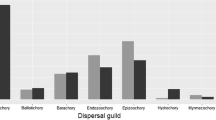Abstract
Dispersal of seeds by adhesion to animals, known as epizoochory, is often referred to as a significant mode of dispersal. Few studies have quantitatively examined this method of dispersal; those that do often concentrate on mammalian rather than avian dispersers. To measure the extent of this form of seed dispersal, we studied the external seed loads on the feet and feathers of four waterfowl species found in a salt marsh on the New Jersey shore. More than 75% of the birds were found to be carrying seeds, mostly on their feathers. The seeds of twelve plant species, predominantly from salt marsh plants and particularly salt grass (Distichlis spicata) and cordgrass (Spartina alterniflora), were identified in the samples. All but one species has seeds with potentially adhesive structures. Results indicate that for many salt marsh plant species, seed dispersal by adhesion to waterfowl may be a significant method of seed transport.
Similar content being viewed by others
Literature cited
Agnew, A. D. Q. and J. E. C. Flux. 1970 Plant dispersal by hares (Lepus capensis, L.) in Kenya. Ecology 51:735–737.
Bullock, S. H. and R. B. Primack. 1977. Comparative experimental study of seed dispersal on animals. Ecology 58:681–686.
Carlquist, S. 1966. The biota of long-distance dispersal. I. Principles of dispersal and evolution. Quarterly Review of Biology 41: 247–270.
Darwin, C. 1859. On the Origin of Species. Murray, London, England.
Palmer, R. S. 1976. Handbook of North American Birds. Vol. 2. Yale University Press, New York, NY, USA.
Porter, D. M. 1976. Geography and dispersal of Galapagos Islands vascular plants. Nature 264:745–746.
Ridley, H. N. 1930. The Dispersal of Plants throughout the World. Reeve, London, England.
Robichaud, B. and M. F. Buell. 1973. Vegetation of New Jersey. A study of landscape diversity, Rutgers University Press, New Brunswick, NJ, USA.
Salisbury, E. J. 1970. The pioneer vegetation of exposed muds and its biological features. Philosophical Transactions of the Royal Society of London (B) 259:207–255.
Smith, L. M., R. L. Pederson, and R. M. Kaminsky. 1989. Habitat management for migrating and wintering waterfowl in North America. Texas Tech University Press, Lubboch, TX, USA.
Smith, L. M., L. D. Vangilder, and R. A. Kennamer. 1985. Foods of wintering brant in eastern North America. Journal of Field Ornithology 56:286–289.
Sorenson, A. E. 1986. Seed dispersal by adhesion. Annual Review of Ecology and Systematics 17:443–63.
Taylor, B. W. 1954. An example of long-distance dispersal. Ecology 35:569–72.
van der Pijl, L. 1982. Principles of dispersal in higher plants. Springer Verlag, Berlin, Germany.
Author information
Authors and Affiliations
Rights and permissions
About this article
Cite this article
Vivian-Smith, G., Stiles, E.W. Dispersal of salt marsh seeds on the feet and feathers of waterfowl. Wetlands 14, 316–319 (1994). https://doi.org/10.1007/BF03160638
Received:
Revised:
Accepted:
Issue Date:
DOI: https://doi.org/10.1007/BF03160638




